
Date:
Tariff Pause Triggers Early Transpacific Peak Season
The 90-day suspension of US-China tariffs has delivered a sharp jolt to transpacific ocean freight, triggering an unseasonal spike in demand and pushing spot rates up significantly.
This unexpected policy reprieve has not only created a narrow window of predictability for US importers, but also accelerated peak season behaviours months ahead of the traditional schedule.
With booking volumes surging and available capacity still constrained, shippers are entering a period of extreme competition for space and elevated freight costs, especially on Asia–US West Coast lanes.
Since the announcement of the tariff pause, transpacific spot rates have climbed steeply. The Shanghai Containerised Freight Index (SCFI) rose by 14% last week, with further gains expected. This marks the largest weekly increase of 2025 so far and reflects mounting pressure on space and capacity across eastbound transpacific routes.
- Shanghai–Los Angeles FEU rates have climbed 16% in just one week.
- Shanghai–New York DEU rates jumped 19%.
While these levels remain well below pandemic highs, they are trending upward quickly, particularly as US importers race to bring in goods during the tariff pause window, which expires on 14 August.
Sudden and Significant Capacity Crunch
The spike in demand has exposed a capacity shortfall that many believed had stabilised. Carriers had withdrawn substantial tonnage from Far East–US West Coast services in April and May, anticipating a slower season. Now, those services are being rapidly reinstated in full as bookings rebound sharply.
Carriers have responded with unusual speed, with suspended loops returning across multiple alliances, vessels are being upsized to handle growing volumes, additional services are being announced and blanked sailings reversed.
Despite these adjustments, near-term capacity remains tight, especially due to ongoing vessel redeployments, congestion at Chinese ports, and bottlenecks at container freight stations (CFS) in China.
Adding to the live bookings, is a wave of previously manufactured cargo stored in bonded warehouses, which is expected to enter the market imminently.
If this stored cargo flows into the system during the remainder of May, demand could spike by 16% to 48% on top of normal levels. If shipments are delayed until June, the increase would ease to a more manageable 5% to 16%, but that assumes no further acceleration from early peak season orders.
Importantly, this analysis does not yet account for traditional peak season volumes, which are expected to surge in the coming weeks as US importers seek to front-load shipments ahead of the 14 August tariff deadline.
Challenges and Considerations
The rapid resurgence in volumes is pushing logistics networks to their limits. Shippers can expect tight space availability, higher rates, with ongoing volatility through June and July, possible rollovers, even on confirmed bookings, and longer dwell times, with delays at origin due to congestion
While carriers are acting quickly to rebalance networks, the sheer speed and scale of the demand rebound mean constraints are likely to persist through Q3.
As always, Metro is working closely with clients to minimise disruption and capitalise on available capacity. With robust freight forwarding capabilities, deep ocean carrier relationships, and on-the-ground presence in the United States, we’re helping customers:
- Secure space and locked-in rates on core transpacific lanes
- Prioritise high-value or time-sensitive cargo
- Adjust routing strategies to reduce risk and maintain delivery schedules
With early peak season now well under way, proactive planning is essential. Space is already tightening, and costs will likely continue to climb in the lead-up to August.
If your business relies on Asia–US trade flows, EMAIL Andrew Smith today and learn how we will keep your supply chain running smoothly, despite the disruption.
